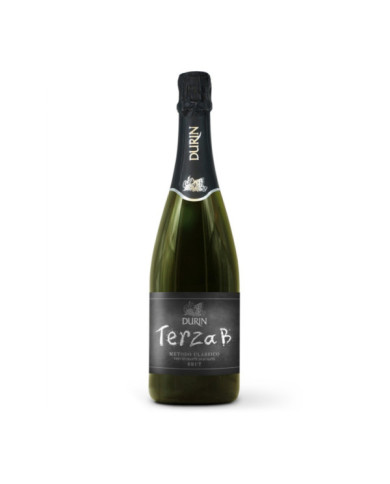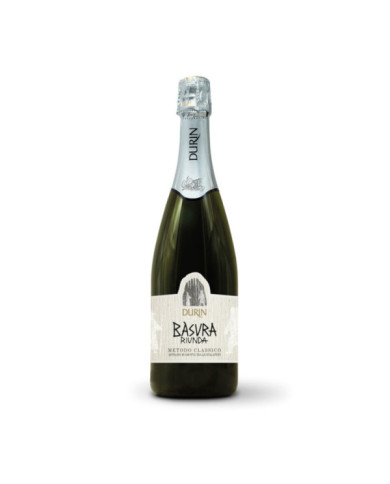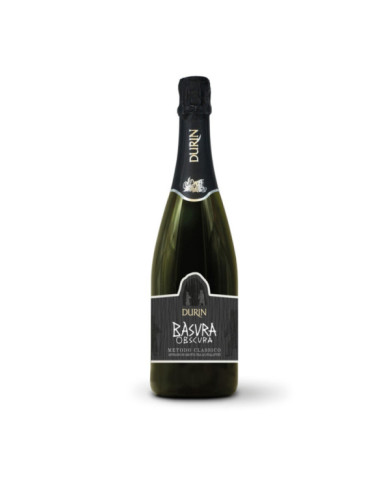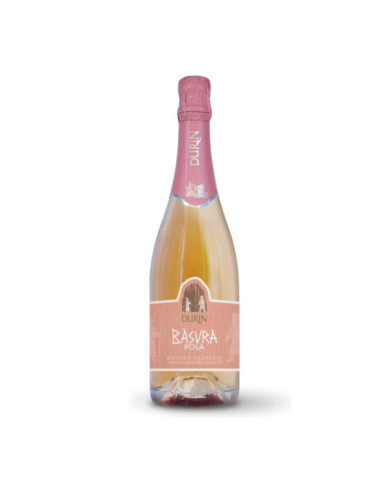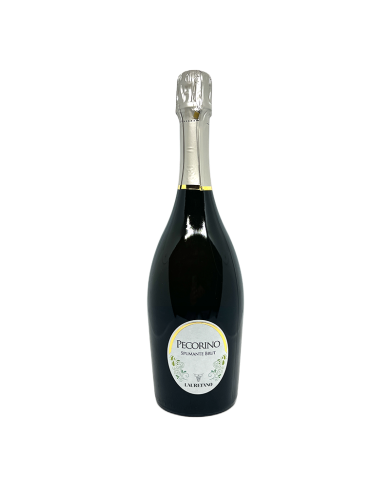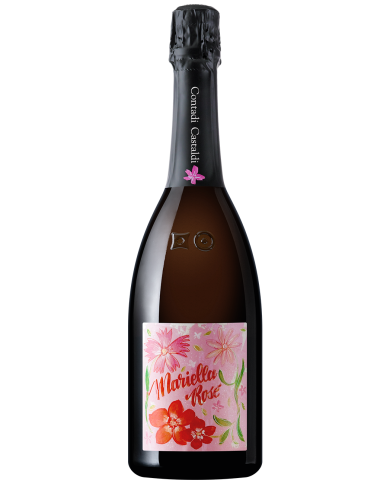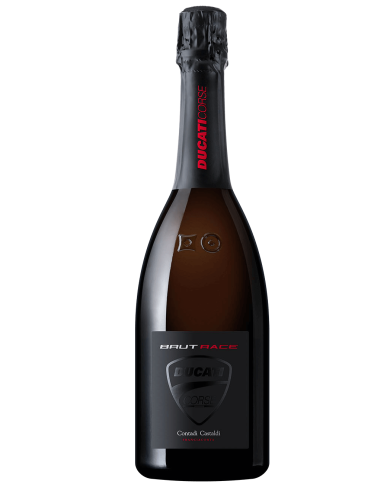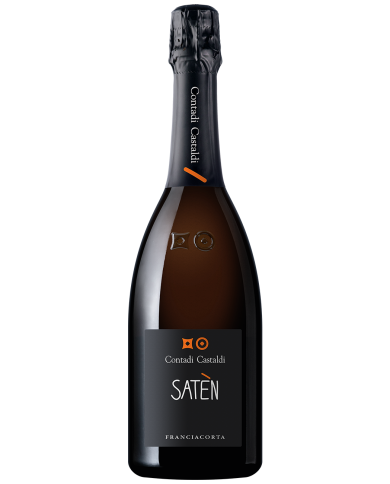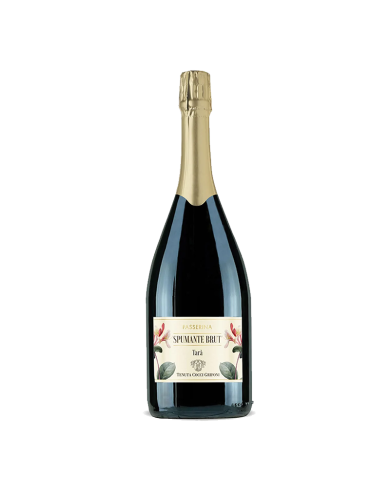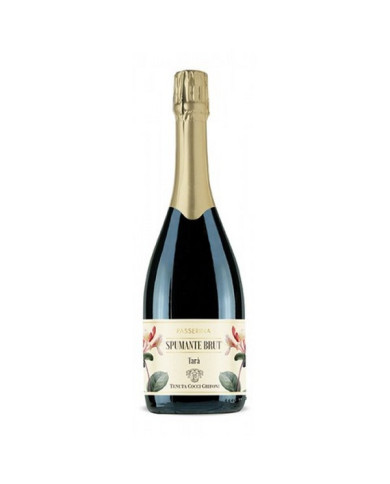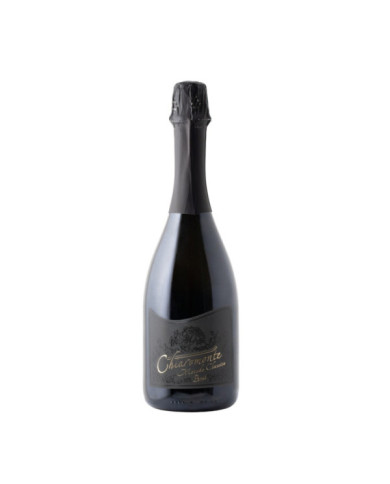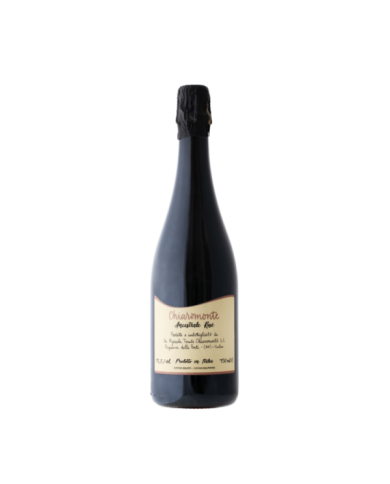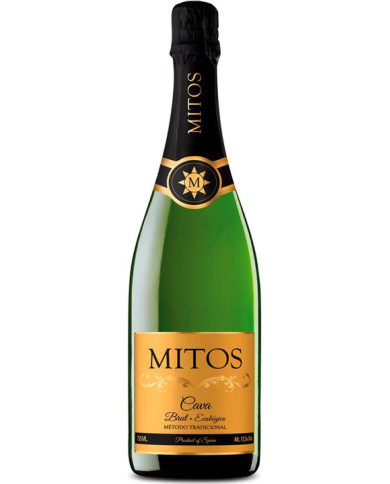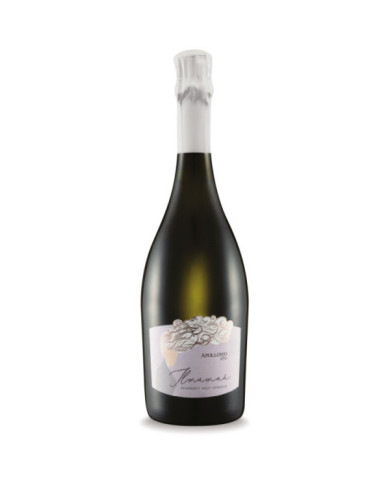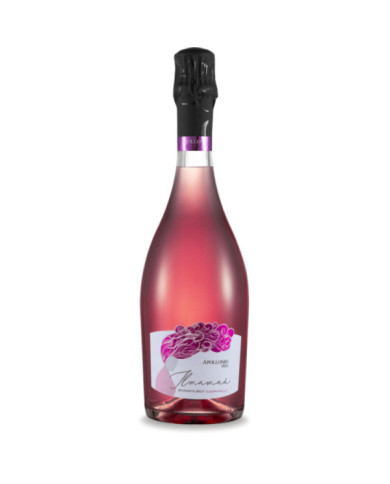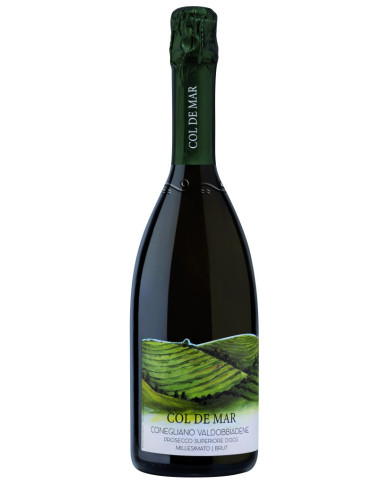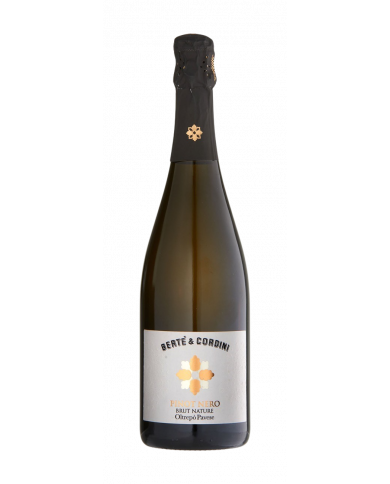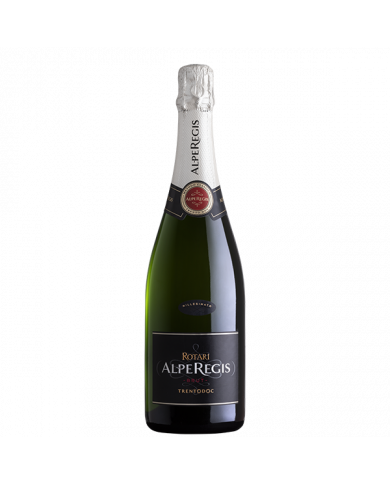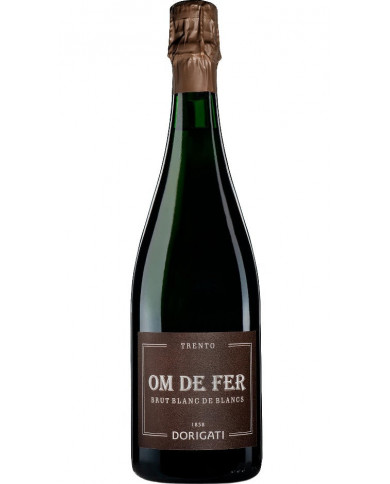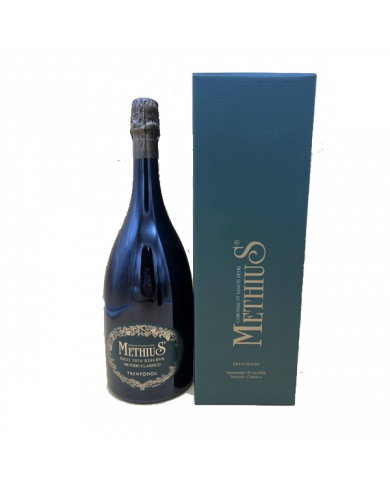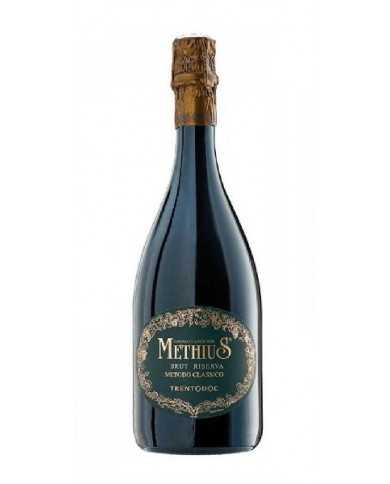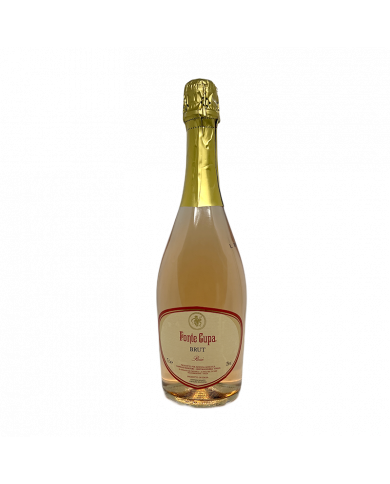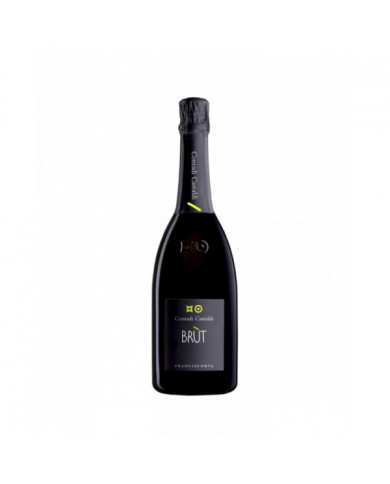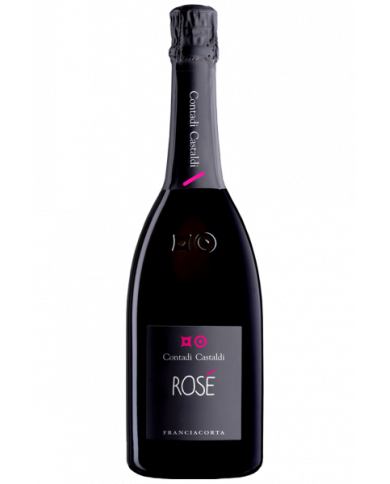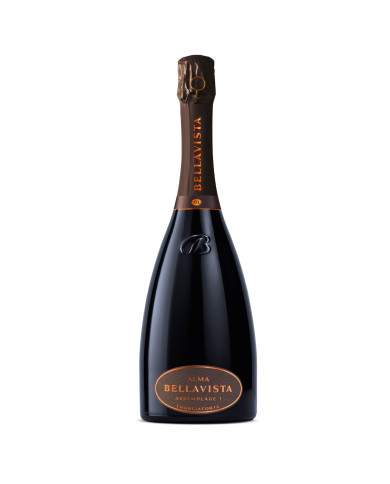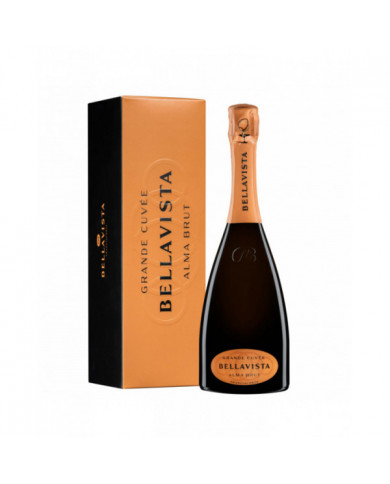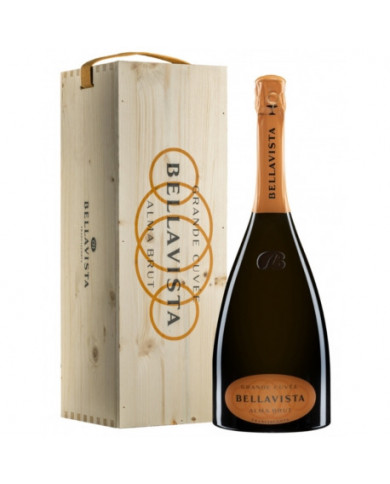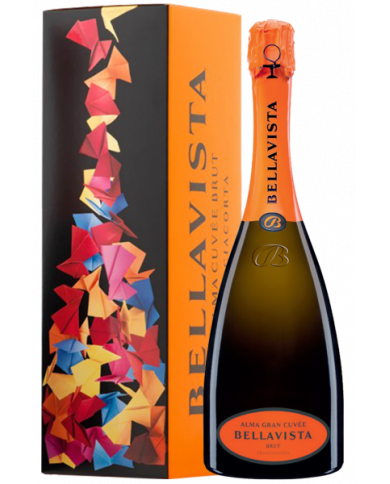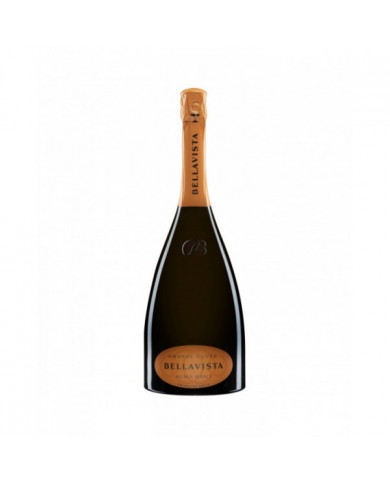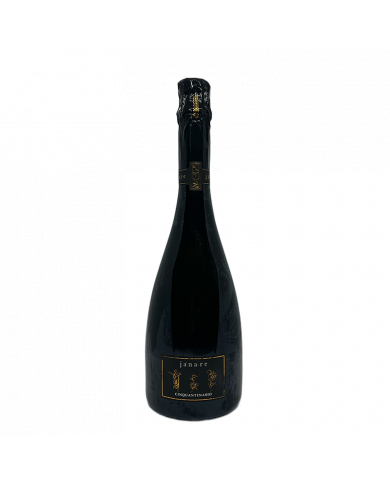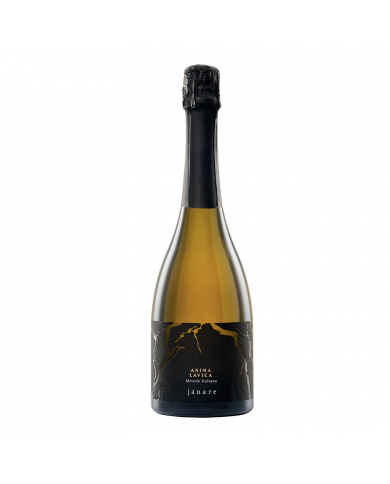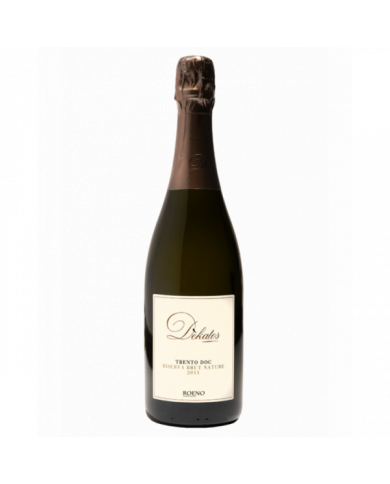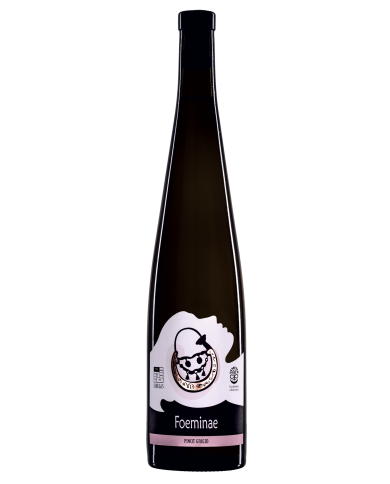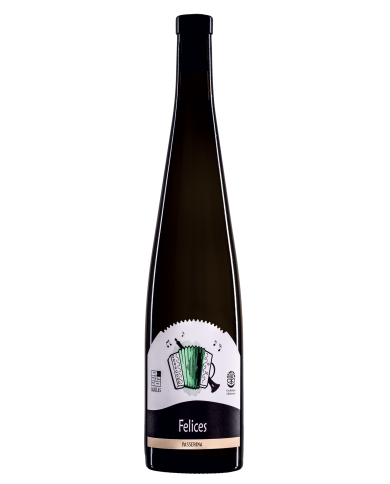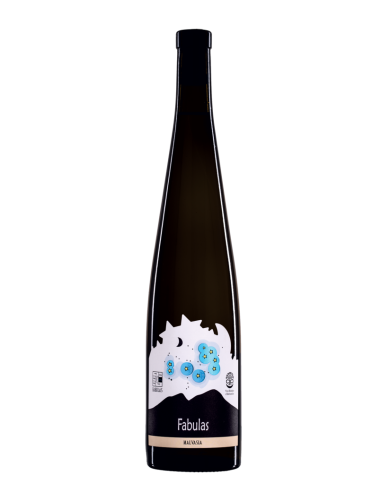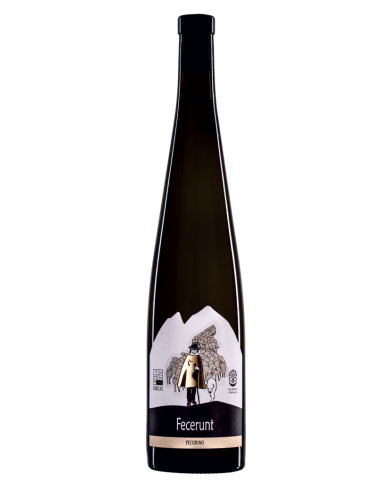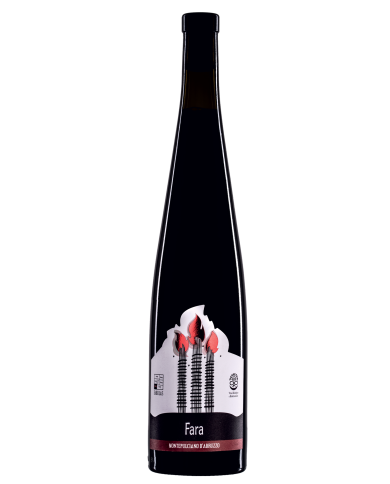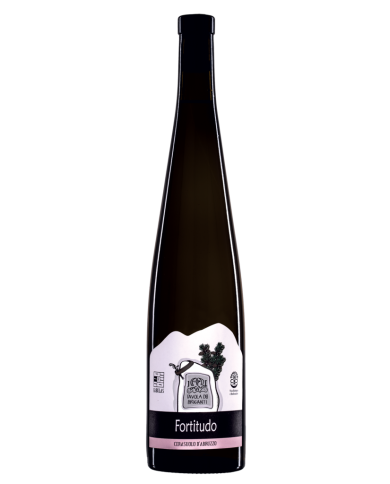Versatile sparkling wine with a fine and persistent perlage. The color is straw yellow. The smell is fine, delicate, broad with hints of yeastŌĆ”
Important sparkling wine with a fine and persistent perlage. The bubbles that caress the palate enhance the great softness and structure... The project of producing a classic method with native vines was born a long time ago with an enormous passion for bubbles and culminates, after years of study, in the production of the first classic method local and especially with the wonderful possibility of maturing this wine inside the caves of Toirano (SV) winding and suggestive in one of the most beautiful corners of Liguria. The caves represent the perfect cellar and "basura" is the witch who gives her name to one of the most suggestive rooms. A short distance away from the remains of the cave bear and from the evidence of prehistoric man who lived 12,000 years ago rest the our bottles in the darkness, silence, cold and constant humidity of the cave. In June 2011 with the first transfer to the cave, done by hand, bottle after bottle, begins a splendid alliance between wine, history and culture enthusiastically supported by the Superintendency of Archaeological Heritage of Liguria e from the municipality of Toirano. The right synergy capable of enhancing this portion of the western Ligurian hinterland as unique in its beauty as in its harshness
Important sparkling wine with a fine and persistent perlage. The bubbles that caress the palate enhance the finesse and elegance of the wineŌĆ” The project of producing a classic method with native vines was born a long time ago with an enormous passion for bubbles and culminates, after years of study, in the production of the first local classic method e especially with the wonderful possibility of maturing this wine inside the caves of Toirano (SV) winding and suggestive in one of the most beautiful corners of Liguria. The caves represent the perfect cellar and "basura" is the witch who gives her name to one of the most suggestive rooms. A short distance away from the remains of the cave bear and from the evidence of prehistoric man who lived 12,000 years ago rest the our bottles in the darkness, silence, cold and constant humidity of the cave. In June 2011 with the first transfer to the cave, done by hand, bottle after bottle, begins a splendid alliance between wine, history and culture enthusiastically supported by the Superintendency of Archaeological Heritage of Liguria e from the municipality of Toirano. The right synergy capable of enhancing this portion of the western Ligurian hinterland as unique in its beauty as in its harshness.
Ros├® sparkling wine with a fine, soft, intense and persistent perlage, with an intense onion skin pink colour. The smell is fine, broad, elegantŌĆ” The project of producing a classic method with native vines was born a long time ago with an enormous passion for bubbles and culminates, after years of study, in the production of the first local and especially with the wonderful possibility of maturing this wine inside the caves of Toirano (SV) winding and suggestive in one of the most beautiful corners of Liguria. The caves represent the perfect cellar and "basura" is the witch who gives her name to one of the most suggestive rooms. A short distance away from the remains of the cave bear and from the evidence of prehistoric man who lived 12,000 years ago rest the our bottles in the darkness, silence, cold and constant humidity of the cave. In June 2011 with the first transfer to the cave, done by hand, bottle after bottle, begins a splendid alliance between wine, history and culture enthusiastically supported by the Superintendency of Archaeological Heritage of Liguria e from the municipality of Toirano. The right synergy capable of enhancing this portion of the western Ligurian hinterland as unique in its beauty as in its harshness.
The color is straw yellow with greenish notes, the fruity scent with citrus notes, persistent. Good structure, excellent freshness, full and intense flavour. Excellent as an aperitif, it accompanies all fish-based dishes revealing a predilection for shellfish and seafood, even raw.
Cuv├®e made only in exceptional years, when Pinot Noir reaches perfection, Mariella is a unique and unforgettable bubble that anyone who loves the genre cannot miss. A blend composed of 90% Pinto Nero and the remaining 10% Chardonnay, Mariella ages for 62 to 70 months according to the Classic Method and stands out for its elegance and complexity, given by the subtle balance between the austerity of Pinot Noir and the softness of Chardonnay, characteristics that give it a remarkable expressive richness and a prominent place in the Franciacorta panorama.
A perfumed wine, which conquers for its original gustatory freshness. The style is played on the search for harmony between complexity and pleasantness. The color is straw yellow, with a fine and persistent perlage. The nose is fresh and elegant, with clear aromas of hawthorn, bread crust, balsamic notes, nuances of rennet apple, dried figs and peanuts. Soft in the mouth, but not sweet, it has a fresh and pleasant taste. The finish is long and decisive, of great gustatory pleasure.
Prosecco wine produced with glera grapes grown in the hilly areas of the denomination which extends for 15 municipalities between Conegliano and Valdobbiadene.
White foam, soft and rich; fine and persistent perlage. Straw yellow color with bright golden reflections. Bouquet rich in white flowers and fruity with hints of pear and tropical fruit. On the palate it is fresh and inviting, complex and full of balance.
AlpeRegis is dedicated to lovers of good food and good living. The name evokes the royal figure of Rotari and the alpine territory that has contributed to making Rotari legendary by setting his deeds in history. This vintage Trentodoc is obtained from a selection of Chardonnay grapes harvested by our winemakers in the mountain vineyards north of Trento. The soft pressing and low-temperature fermentation with selected yeasts allow the aromas of the grapes to express themselves at their best and blend with those produced by the yeasts. In spring, when the base wines have reached the ideal refinement for the second fermentation, the Alperegis Brut cuv├®e is elaborated, assembling the base wines that best express the characteristics of the mountain Chardonnay. Aging on the lees is a minimum of 36 months.
"Om De Fer" Brut Blanc de Blancs ├© un grande metodo classico prodotto dalla famiglia Dorigati col desiderio di creare uno spumante di alta qualit├Ā partendo dalla cuv├©e di tiraggio, con lŌĆÖintento di abbinare allŌĆÖevoluzione e alla complessit├Ā tipiche del metodo classico, la grande freschezza delle bollicine trentine. Per questo il 30% delle uve vengono vendemmiate quando hanno raggiunto una maggiore maturazione in confronto a quelle raccolte per produrre la classica base spumante, questo apporta volume e complessit├Ā. Vengono poi utilizzate botti vecchie, ci├▓ aiuta lo Chardonnay ad avere la fase ossidativa prima della presa di spuma, mentre per aumentare la complessit├Ā olfattiva vengono mischiate con piccole partite di Chardonnay di precedenti raccolte. I vigneti sono coltivati sulle colline pedemontane ghiaiose calcaree di Mezzocorona, colline Avisiane Trentino Alto Adige, ad una altitudine di 200-500 m s.l.m. I vitigni sono allevati a pergola trentina semplice e la vendemmia viene effettuata manualmente nella prima decade di Settembre. La vinificazione prevede una pressatura soffice con frazionamento dei mosti, fermentazione in barrique per un quarto della massa, con affinamento in acciaio inox e barrique vecchie prima del tiraggio; infine avviene un periodo di circa 24 mesi di affinamento sui lieviti. Nel calice sfoggia una bellissima veste di colore giallo paglierino, con perlage fine e persistente. Il profumo si rivela particolarmente intenso e complesso, lievemente agrumato, con sentori di mela cotta e dolci di pasticceria. La spuma ├© molto avvolgente e fine. In bocca risulta estremamente morbido, merito di una buona struttura ed equilibrio acidico. Estremamente fresco nella beva. Questo ├© lŌĆÖOM DE FER: un metodo classico nato per dare gioia e piacere! Un calice estremamente versatile, perfetto come aperitivo e per brindare in ogni occasione, che si abbina perfettamente a qualsiasi piatto marinaro.
Il Trentino ├© una terra indubbiamente vocata alla produzione di basi spumanti. Se si aggiunge una produzione artigianale e rispettosa delle tradizioni ecco che si ottiene TRENTODOC, ovvero il metodo classico trentino.├© da questi presupposti che nel 1986 nasce METHIUS TRENTO DOC grazie allŌĆÖamicizia tra due amici enologi: Carlo Dorigati ed Enrico Paternoster. Il Trento Doc Methius ├© prodotto solo nella tipologia riserva, a sottolineare la qualit├Ā eccelsa di questo prodotto e la sua unicit├Ā. La cantina dŌĆÖinvecchiamento, ubicata a Mezzocorona (Trentino), risale ai primi del 1900, ├© completamente interrata e costruita con i ŌĆ£volti a botteŌĆØ quasi tutti in pietra squadrata. Qui le bottiglie di Methius sostano per 60 mesi, a temperatura e umidit├Ā pressoch├® costanti tutto lŌĆÖanno. Il nome ŌĆ£MethiusŌĆØ deriva dalla ricerca di un toponimo locale che accomuna lŌĆÖorigine del prodotto aziendale al territorio di nascita. LŌĆÖetimo del nome scelto si perde nella storia. Si sa che gi├Ā nel 1150 (Principe Vescovo e Mainardo II conte di Tirolo) il nome delle due borgate site nella ŌĆ£Piana RotalianaŌĆØ erano: Methius Coronae (oggi Mezzocorona) e Methius Sancti Petri (oggi Mezzolombardo) ove il radicale comune ŌĆ£MethiusŌĆØ deriva dal celtico e latino volgare.
Il Trentino ├© una terra indubbiamente vocata alla produzione di basi spumanti. Se si aggiunge una produzione artigianale e rispettosa delle tradizioni ecco che si ottiene TRENTODOC, ovvero il metodo classico trentino.├© da questi presupposti che nel 1986 nasce METHIUS TRENTO DOC grazie all'amicizia tra due amici enologi: Carlo Dorigati ed Enrico Paternoster. Il Trento Doc Methius ├© prodotto solo nella tipologia riserva, a sottolineare la qualit├Ā eccelsa di questo prodotto e la sua unicit├Ā. La cantina d'invecchiamento, ubicata a Mezzocorona (Trentino), risale ai primi del 1900, ├© completamente interrata e costruita con i "volti a botte" quasi tutti in pietra squadrata. Qui le bottiglie di Methius sostano per 60 mesi, a temperatura e umidit├Ā pressoch├® costanti tutto l'anno. Il nome "Methius" deriva dalla ricerca di un toponimo locale che accomuna l'origine del prodotto aziendale al territorio di nascita. L'etimo del nome scelto si perde nella storia. Si sa che gi├Ā nel 1150 (Principe Vescovo e Mainardo II conte di Tirolo) il nome delle due borgate site nella "Piana Rotaliana" erano: Methius Coronae (oggi Mezzocorona) e Methius Sancti Petri (oggi Mezzolombardo) ove il radicale comune "Methius" deriva dal celtico e latino volgare.
Live wine, organic and biodynamic (Demeter) with spontaneous fermentation, without added sulphites, unfiltered, with fermentation lees.
Even in Contadi Castaldi 's Brut, as in all the other products, chardonnay has an absolute protagonist role. The result is a sparkling wine rich in fragrance, never predictable, which favors smoothness and an accessible sensorial language. A Franciacorta with a balanced and versatile style, perfect for any occasion.
Alma Cuv├®e is born from the skilful union of about 60 of the 120 harvest selections obtained in the cellar. About 100 selections come from the same harvest and are identified with extreme care in 107 parcels distributed in 10 different municipalities of Franciacorta ("horizontal assembly"). To this vast patrimony of olfactory and gustatory variations are then added the aromas and flavors of particular "reserve wines" from different harvests ("vertical assembly"). A unique cuv├®e, which with its elegant complexity represents the most complete and often mysterious soul of Franciacorta.
The Franciacorta DOCG Cuv├©e Brut "Alma" by Bellavista comes from the skilful union of about 60 of the 120 harvest selections obtained in the cellar. About 100 selections come from the same harvest and are identified with extreme care in 107 parcels distributed in 10 different municipalities of Franciacorta ("horizontal assembly"). To this vast patrimony of olfactory and gustatory variants are then added the aromas and flavors of particular "reserve wines" from different vintages ("vertical assembly"). A unique cuv├®e, which with its elegant complexity represents the most complete and often mysterious soul of Franciacorta.
Brilliant straw yellow colour, characteristic fruity bouquet of good intensity with hints of cedar, citrus, white fruit and yeasts. Pleasant, with a good structure and excellent persistence. Balanced.
Straw yellow color with green reflections. The nose expresses floral hints of orange blossom completed by nuances of flint and yeasts. The taste is elegant, savoury, soft and very persistent, confirming the olfactory hints of citrus.
Dekatos is above all a Classic Method of substance and inspiration, transforming it into the identity of the territory. Dekatos is a Classic Method with a long permanence sur lie, over one hundred months to connote and chisel a unique style. Dekatos breathes the art and the wind of the Trentino latitudes, where the vocation for the great Classical Methods has made it possible to write important pages within the history of Italian winemaking.
Grape variety: CHARDONNAY 100% fermentation in stainless steel tanks Altitude: 410 meters slm Slope: 17% facing East Training system: Low Guyot Soil: 30% tufa - 68% sandstone - 2% calcium Average yield per hectare: 55 hl.
Brut Sparkling Wines: A Complete Guide to Italian Sparkling Wines
Bubbles have always been associated with celebrations and special moments. Brut sparkling wines are one of the most loved and widespread types in Italy. In this comprehensive guide, we'll explore everything there is to know about Brut sparkling wines , from their production, tastes and pairings, to the best labels available on the market.
What is a Brut Sparkling Wine?
Brut sparkling wine is a sparkling wine characterized by a low amount of residual sugar. The term "Brut" refers to the level of sweetness of the wine, and in this case, indicates that the wine is dry, with less than 12 grams of residual sugar per litre. This makes it a very popular choice for those who prefer less sweet and more refreshing wines.
Method of Production
Brut sparkling wines are mainly produced using two methods: Classic Method and Charmat Method.
Classic method
The Classic Method is also known as the Traditional Method or Champenoise Method and is the method used to produce Champagne. In this process, the base wine ferments a second time in the bottle, creating natural bubbles and enriching the aromas and flavours. It is a long and complex method, but the result is a wine of great elegance and structure.
Charmat method
The Charmat Method, also known as the Italian Method, is a faster and more efficient process. The base wine ferments a second time in large stainless steel tanks, maintaining the freshness and fruitiness of the wine. This method is often used for younger and lighter sparkling wines.
Characteristics of Brut Sparkling Wines
Brut sparkling wines have several characteristics that make them unique and distinctive:
Lively acidity
The Bruts have a lively acidity that makes them fresh and inviting on the palate. This acidity balances out the lack of sweetness, creating a harmonious balance.
Fruity aromas
Brut sparkling wines offer a wide range of fruity aromas, such as green apple, citrus and white peach. These fresh and fruity aromas make these wines ideal as an aperitif or as an accompaniment to light dishes.
Fine and persistent bubbles
The bubbles of Brut sparkling wines are fine and persistent, creating a pleasant sensation of fizz in the mouth.
Versatility in Pairings
Thanks to their acidity and structure, Brut sparkling wines go well with a wide range of foods, from seafood to white meats, and are also perfect to be enjoyed alone in moments of celebration.
The Best Labels of Italian Brut Sparkling Wines
Italy boasts a large selection of sparkling Brut wines , produced in different regions of the country. Here are some of the best labels to try:
1. Ferrari Trento Brut
Produced in Alto Adige, Ferrari Trento Brut is one of the most renowned Italian sparkling wines. With its notes of green apple and bread crust, it is an elegant and refined wine.
2. Ca' del Bosco Cuv├®e Prestige Brut
From Lombardy comes the Ca' del Bosco Cuv├®e Prestige Brut, a structured and complex wine with aromas of citrus and yeast.
3. Berlucchi '61 Franciacorta Brut
Berlucchi '61 Franciacorta Brut is another unmissable Italian sparkling wine. With its freshness and creaminess, it is perfect for any occasion.
4. La Gioiosa Prosecco Superiore Brut
If you prefer a lighter option, the La Gioiosa Prosecco Superiore Brut from the Veneto region is an ideal choice. Delicate and aromatic, it is perfect for a cheerful toast.
The History of Brut Sparkling Wines
The tradition of sparkling wines in Italy has ancient roots and has its origins in ancient Rome. However, the success of Brut sparkling wines as we know them today is mainly linked to the Champagne region of France, where the Classic Method took hold in the 17th century. Since then, this style of production has spread throughout Italy, resulting in the delicious Brut sparkling wines that we love and appreciate today.
How to Store and Serve Brut Sparkling Wines
To fully enjoy the bubbles of Brut sparkling wines , it is essential to store and serve them correctly.
storage
Store Brut sparkling wines in a cool, dark place, away from direct sunlight and heat sources. Avoid sudden changes in temperature and keep them horizontal to keep the cap moist.
Service
To serve Brut sparkling wine at the right temperature, chill it in the refrigerator for at least two hours before opening it. The ideal serving temperature is between 6┬░C and 8┬░C. Pour the wine by tilting the glass at 45 degrees to preserve the bubbles as much as possible.
Brut sparkling wines represent the charm and elegance of Italian bubbles. With their lively acidity, fruity aromas and fine bubbles, they are a perfect choice for any celebration and special moment. Explore the vast selection of labels available and delight your guests with the refined taste of Brut sparkling wines .
Frequent questions
What is the difference between a Brut sparkling wine and an Extra Dry sparkling wine?
The main difference lies in the level of sweetness. A Brut sparkling wine is dry, while an Extra Dry is slightly sweeter.
How long does a bottle of Brut sparkling wine keep?
Most Brut sparkling wines are best kept for about 2-3 years from the date of production. However, some of them can age even better.
What are the main grape varieties used to produce Italian Brut sparkling wines?
Among the most used grape varieties are Chardonnay, Pinot Noir and Pinot Blanc, but there are many other regional varieties that are used.
Can I combine a Brut sparkling wine with a plate of red meat?
Yes, but it's better to opt for a more structured and complex Brut, like a Franciacorta or a Trentodoc.
What makes Italy such a renowned region for the production of sparkling wines?
Italy has a variety of terroirs and microclimates which allow for the cultivation of different grapes suitable for the production of high quality sparkling wines. The country's long winemaking tradition has also contributed to the development of refined production techniques.

